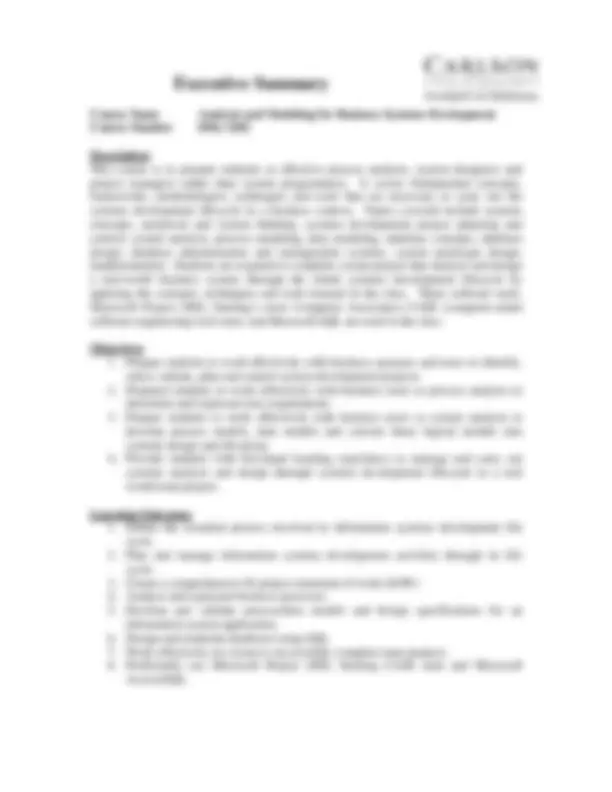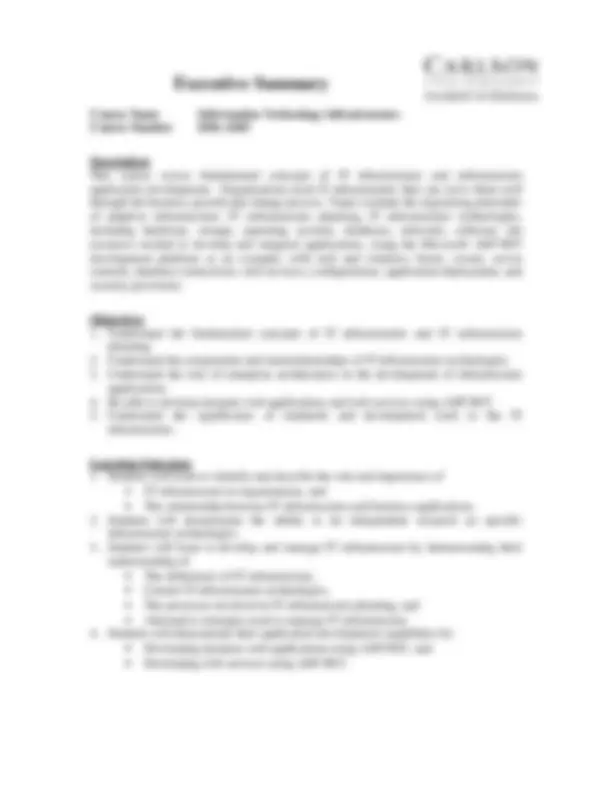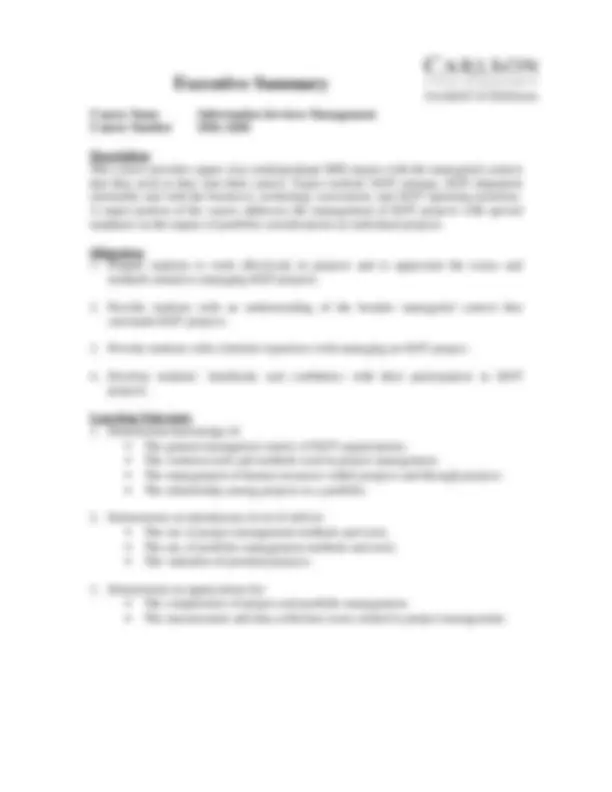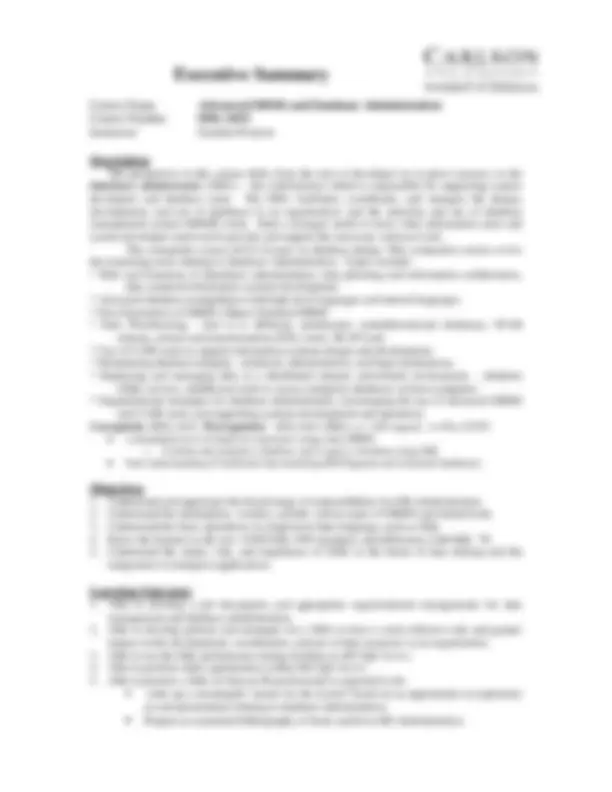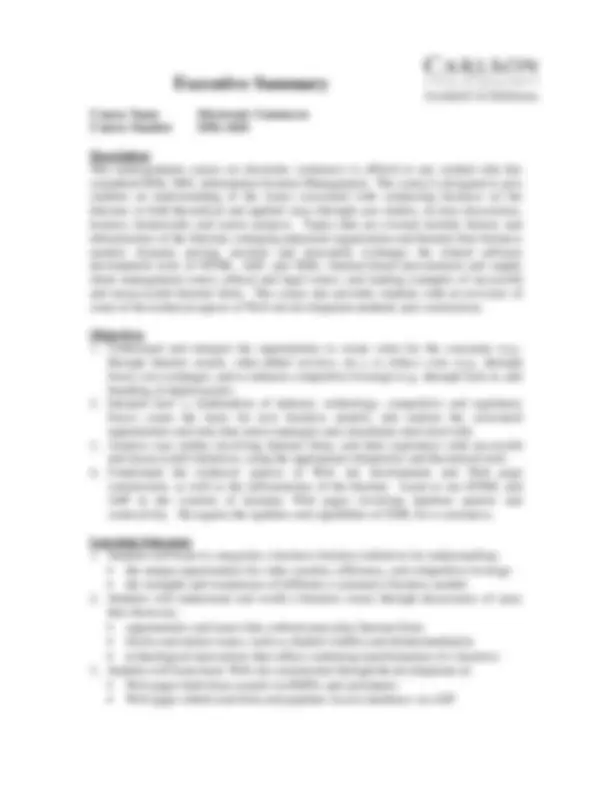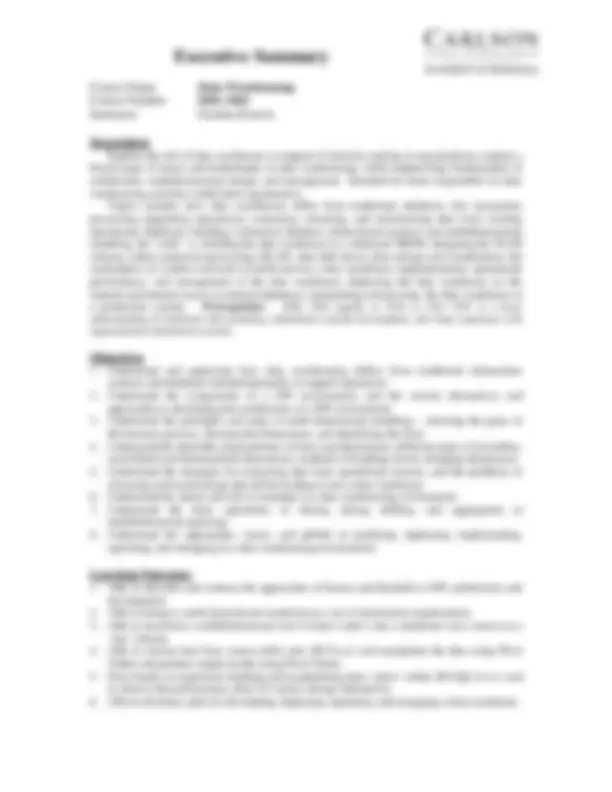Download Information Systems and Programming Courses for MIS Majors and more Lecture notes Database Management Systems (DBMS) in PDF only on Docsity!
Course Name Information Systems for Business Processes and Management Course Number IDSc 3001
Description
The increased application of information technologies has fundamentally altered the
nature of work, business processes and the nature of competition in the past decade. This
course is designed to examine issues surrounding the design, application and effective
use of information systems in organizations. The course will develop students into
business professionals who can participate effectively in conceiving, planning, building
and managing information systems in organizations. The course has a lab component to
expose students to the hands-on use of a database management system.
Objectives o Discuss the role of information systems in o Supporting business processes o supporting new forms of communication, collaboration and decision making o Organizational processes involved in planning, implementing and developing organizational information systems. o Hands-on training in the use of information systems Learning Outcomes
- Students will have a good understanding of:
- how business processes redesign is linked to the ability of firms to leverage IT capabilities
- how information systems enable firms to manage organizational knowledge and enhance efficiency and effectiveness
- the role of information systems in enabling firms to derive competitive advantages
- Strong skills in using Microsoft Access
Course Name Introduction to Programming for Systems Development Course Number IDSc 3201
Description This course is a required course for the MIS major in the undergraduate program. The course primarily draws from MIS majors, although other students enroll also, e.g., computer science students or students majoring in other programs in the Carlson School. IDSc 3201 does not assume any background in programming, although some students in the course have some programming background. The course is designed to provide an introduction to programming and program design. Students get hands-on use of a current application development environment and contemporary development tools. Half of the lectures are held in a computer lab. Currently, the selected set of tools is Microsoft Visual Basic .NET, a complete suite of tools for creating standalone applications, portions of larger systems, independent objects, complete distributed systems, and active components of the World Wide Web. Visual Basic also serves as the underlying macro language for Microsoft Office, the most widely used desktop office suite.
Objectives
- Understand the concepts, process, and tools necessary to build a software application.
- Understand the basics of programming and program design, including:
a. Programming language syntax and control logic; b. User interface design; c. File and database access; d. Structured, event, and object-oriented design; e. Coding, testing, and debugging.
- Hands on use of contemporary development tools.
Learning Outcomes
- Students will learn the basics of programming in a current programming language.
- Such knowledge is expected to generalize to allow them to learn other languages in the future. A maxim understood by all programmers is: “Learn one programming language well and the rest are easy.”
- Students will be able to work with a visual development environment to create working system applications.
- Students will understand concepts of application design, and be able to create a user- friendly application.
Course Name Information Technology Infrastructure Course Number IDSc 4203
Description This course covers fundamental concepts of IT infrastructure and infrastructure application development. Organizations need IT infrastructure that can serve them well through the business growth and change process. Topics include the organizing principles of adaptive infrastructure; IT infrastructure planning, IT infrastructure technologies, including hardware, storage, operating systems, databases, networks, software; the resources needed to develop and integrate applications, using the Microsoft ASP.NET development platform as an example, with web and windows forms, events, server controls, database connections, web services, configurations, application deployment, and security provisions.
Objectives
- Understand the fundamental concepts of IT infrastructure and IT infrastructure planning.
- Understand the components and interrelationships of IT infrastructure technologies.
- Understand the role of enterprise architectures in the development of infrastructure applications.
- Be able to develop dynamic web applications and web services using ASP.NET.
- Understand the significance of standards and development tools to the IT infrastructure.
Learning Outcomes
- Students will learn to identify and describe the role and importance of
- IT infrastructure in organizations, and
- The relationship between IT infrastructure and business applications.
- Students will demonstrate the ability to do independent research on specific infrastructure technologies.
- Students will learn to develop and manage IT infrastructure by demonstrating their understanding of - The definitions of IT infrastructure, - Current IT infrastructure technologies, - The processes involved in IT infrastructure planning, and - Alternative strategies used to manage IT infrastructure.
- Students will demonstrate their application development capabilities by:
- Developing dynamic web applications using ASP.NET, and
- Developing web services using ASP.NET.
Course Name Information Services Management Course Number IDSc 4204
Description This course provides upper class undergraduate MIS majors with the managerial context that they need as they start their careers. Topics include: IS/IT strategy, IS/IT alignment (internally and with the business), technology assessment, and IS/IT operating positions. A major portion of the course addresses the management of IS/IT projects with special emphasis on the impact of portfolio considerations on individual projects.
Objectives
- Prepare students to work effectively in projects and to appreciate the issues and methods related to managing IS/IT projects.
- Provide students with an understanding of the broader managerial context that surrounds IS/IT projects.
- Provide students with a limited experience with managing an IS/IT project.
- Develop students’ familiarity and confidence with their participation in IS/IT projects.
Learning Outcomes
- Demonstrate knowledge of:
- The general managerial context of IS/IT organizations.
- The common tools and methods used in project management.
- The management of human resources within projects and through projects.
- The relationship among projects in a portfolio.
- Demonstrate an introductory level of skill in:
- The use of project management methods and tools.
- The use of portfolio management methods and tools.
- The valuation of potential projects.
- Demonstrate an appreciation for:
- The complexities of project and portfolio management.
- The measurement and data collection issues related to project management.
Course Name Advanced Database Design Course Number IDSc 4431 Instructor Gordon Everest
Description The perspective in this course (and 4432) shifts from the user or developer (as in prior courses), to the data(base) administrator (DBA). The DBA facilitates, coordinates, and manages the design, development, and use of databases in an organization. This course focuses on the most important task within database administration – database design and “getting it right.” Topics include: the basics of ER/relational database modeling and the principles of data normalization; a comprehensive taxonomy and comparison of data modeling schemes; Object Role Modeling (ORM), subtypes/supertypes, data model presentation and validation; conducting a data modeling project; mapping an ORM data model to a relational model; and queries in ORM. Prerequisites : IDSc 6201 (MBA), or 3202 (ugrad), or 4103, or CSci 4/5707:
- a meaningful level of hands-on experience using some DBMS o to define and populate a database, and to query a database using SQL
- basic understanding of traditional data modeling (ER Diagrams and relationsl databases). Text : Terry Halpin, Information Modeling and Relational Databases , Morgan-Kaufmann, 2001.
Objectives
- Understand the semantics of an ER Diagram and how to extend it.
- Comprehend the limitations of ER modeling, that is, thinking in terms of relational tables.
- Understand functional dependencies and the principles of database normalization.
- Develop a thorough understanding of Object Role Modeling (ORM) as a better starting point for conceptual database modeling compared to record-based data modeling. a. Basic constructs – elementary fact sentences (with subject and predicate), objects, relationships and roles, reference modes, nested predicates, ternary facts. b. Constraints – dependency, uniqueness, entity set, roles, frequency, ring.
- Understand subtype-supertype relationships and when they are appropriate in data modeling.
- Understand the desirable characteristics of a data model presentation for people.
- Understand the process of logical database design – in projects involving the users.
Learning Outcomes
- Able to develop a correct ER diagram (data model) for a variety of information semantics.
- Able to identify and correct violations of the three normal forms used in database design.
- Able to use MS Visio for Enterprise Architects (VEA, part of Visual Studio.net for EA) to develop a conceptual data model using the ORM data modeling scheme, check the validity of the model and correct any errors, and then to generate the logical data model as relational tables and the DDL script for some target DBMS.
- Able to recognize and correctly model subtype-supertype relationships.
- Able to transform an ORM diagram into an equivalent relational table design.
- Able to plan and conduct a successful database design project.
- Able to produce database design documentation which effectively communicates understanding to people in the using environment.
Course Name Advanced DBMS and Database Administration Course Number IDSc 4432 Instructor Gordon Everest
Description The perspective in this course shifts from the user or developer (as in prior courses), to the data(base) administrator (DBA) -- the role/function which is responsible for supporting system developers and database users. The DBA facilitates, coordinates, and manages the design, development, and use of databases in an organization; and the selection and use of database management system (DBMS) tools. Such a manager needs to know what information users and system developers need and to provide and support the necessary software tools. The corequisite course (4431) focuses on database design. This companion course covers the remaining areas relating to Database Administration. Topics include:
- Role and functions of data(base) administration, data planning and information architectures, data-centered information systems development.
- Advanced database manipulation with high-level languages and natural languages.
- Next Generation of DBMS; Object-Oriented DBMS
- Data Warehousing – how it is different, architecture, multidimensional databases, STAR schema, extract and transformation (ETL) tools, OLAP tools.
- Use of CASE tools to support information systems design and development.
- Maintaining database integrity, -technical, administrative, and legal mechanisms.
- Deploying and managing data in a distributed (shared, networked) environment -- database (SQL) servers, middleware tools to access enterprise databases on host computers.
- Organizational strategies for database administration, encouraging the use of advanced DBMS and CASE tools, and supporting systems development and operations. Corequisite: IDSc 4431. Prerequisites : IDSc 6201 (MBA), or 3202 (ugrad), or CSci 4/5707:
- a meaningful level of hands-on experience using some DBMS o to define and populate a database, and to query a database using SQL
- basic understanding of traditional data modeling (ER Diagrams and relationsl databases).
Objectives
- Understand and appreciate the broad range of responsibilities for DB Administration.
- Understand the marketplace, vendors, and the various types of DBMS and related tools.
- Understand the basic operations in a high-level data language, such as SQL.
- Know the features in the new ANSI SQL:1999 standard, and differences with SQL ’92.
- Understand the nature, role, and importance of XML to the future of data sharing and the integration of enterprise applications.
Learning Outcomes
- Able to develop a job description and appropriate organizational arrangements for data management and database administration.
- Able to develop policies and strategies for a DBA to have a more effective role and greater impact on the development, coordination, and use of data resources in an organization.
- Able to use the SQL performance tuning facilities in MS SQL Server.
- Able to perform index optimization within MS SQL Server.
- Able to practice a little of what an IS professional is expected to do:
- write up a meaningful ‘memo for the record’ based on an opportunity to experience an oral presentation relating to database administration.
- Prepare an annotated bibliography of items useful to DB Administration.
Course Name Data Warehousing Course Number IDSc 4461 Instructor Gordon Everest
Description Explore the role of data warehouses in support of decision making in organizations; explore a broad range of issues and technologies in data warehousing, while emphasizing fundamentals of architecture, multidimensional design, and management. Intended for those responsible for data warehousing activities within their organization. Topics include: how data warehouses differ from traditional databases (for transaction processing supporting operations); extracting, cleansing, and transforming data from existing operational databases, building a historical database; dimensional analysis and multidimensional modeling, the "cube" vs. building the data warehouse in a relational DBMS, designing the STAR schema; online analytical processing (OLAP), data drill down; data mining and visualization; the marketplace of vendors and tools to build and use a data warehouse; implementation, operational performance, and management of the data warehouse; deploying the data warehouse on the internet and internet access to internal databases; maintaining and growing the data warehouse as a production system. Prerequisites : IDSc 3202 (ugrad), or 4103, or CSci 4707, or a basic understanding of traditional data modeling, information systems development, and some experience with organizational information systems.
Objectives
- Understand and appreciate how data warehousing differs from traditional information systems and databases intended primarily to support operations.
- Understand the components of a DW environment, and the various alternatives and approaches to developing the architecture of a DW environment.
- Understand the principles and steps of multi-dimensional modeling – selecting the grain of the business process, choosing the dimensions, and identifying the facts.
- Understand the desirable characteristics of facts and dimensions, different types of fact tables, snowflaked and denormalized dimensions, methods of handling slowly changing dimensions.
- Understand the strategies for extracting data from operational sources, and the problems of cleansing and transforming data before loading it into a data warehouse.
- Understand the nature and role of metadata in a data warehousing environment.
- Understand the basic operations of slicing, dicing, drilling, and aggregation in multidimensional querying.
- Understand the approaches, issues, and pitfalls in justifying, deploying, implementing, operating, and managing in a data warehousing environment.
Learning Outcomes
- Able to describe and contrast the approaches of Inmon and Kimball to DW architecture and development.
- Able to design a multi-dimensional model given a set of information requirements.
- Able to transform a multidimensional view of data (‘cube’) into a relational view, known as a ‘star’ schema.
- Able to extract data from source tables into MS Excel , and manipulate the data using Pivot Tables and produce output results using Pivot Charts.
- Have hands-on experience building and manipulating data ‘cubes’ within MS SQL Server and to observe the performance effect of various storage alternatives.
- Able to develop a plan for developing, deploying, operating, and managing a data warehouse.
Course Name Information Systems Special Topics – Client Side Web Programming with JAVA Course Number IDSc 4490
Description Java is programming language of choice for the World Wide Web (WWW). Its platform independent deployment allows organizations and programmers to write computer software without worrying about users' choice of platform (to a large extent). Java is used for many programming tasks such as Windows Programming or Native Application programming (such as with VB or C++) and other adaptations of Java (such as Jini) will soon power your cell phones, toasters, and other home appliances. However, this course focuses entirely on Applet programming or in other words the programs that run in browsers when an HTML with an embedded Applet is downloaded. The reason for this focus is that the largest install base of Java programs is as Applets and while there are some implementation specific differences, the core of programming methodology remains the same for Java Applications that can run on any computer with Java Virtual Machine (JVM).
Objectives
- To acquaint students with Java programming language.
- Introduce students to Java’s most commonly used classes to create interactive applets.
- Familiarize students to Graphics programming.
- Familiarize students to Event programming.
- Familiarize Students to User Interface programming.
Learning Outcomes
- Demonstrate knowledge of:
- Programming with Java
- Using different Java Classes
- Creating modular programs
- Defining new java classes
- Demonstrate an introductory level of skill in:
- Creating Applets
- Interacting Applet methods from HTML
- Creating User interface s in Java
- Designing Algorithms
- Utilizing java documentation to search for appropriate base classes
- Demonstrate an appreciation for:
- Object oriented programming
- Multi-use objects
- Abstract classes and Abstract Data Types

